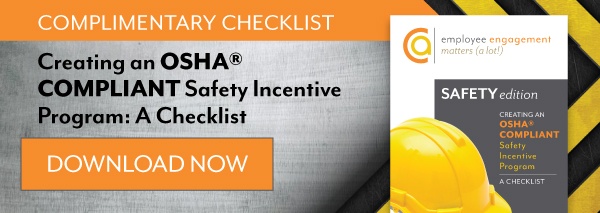The Challenges of Incentivized Safety
When building an effective recognition strategy for the workplace, incentive programs can play a key role in developing higher levels of active engagement. Combined with additional tactics, such as employee referrals, milestone awards and wellness packages, these efforts have the potential to increase productivity, employee ownership and even individual self-worth. Keep in mind that if you choose to incentivize your company’s safety program, it must be done in a manner that’s conducive to your policies, efforts and regulations. If incorrectly set into motion, you run the risk of encouraging team members and managers to hide and/or not report injuries that occur. 
What does OSHA® say?
OSHA® recently clarified their stance on incentive programs via white paper. Citing several sources that relate to improperly implemented programs, OSHA succinctly summed up their stance by stating:
“ [Incentive] programs must be structured in such a way as to encourage safety in the workplace
without discouraging the reporting of injuries and illnesses.”
OSHA reached this decision, in part, by examining a company that would host periodic prize drawings for large items, such as flat screen TVs, and not allow employees who reported an OSHA-recordable injury to enter. Unfortunately, this was not an isolated incident involving just one company. So, while OSHA fully supports utilizing incentive programs, companies must be certain that they have created an effective program that actually encourages safety.
Incentivizing Towards Safegagement™
So, how can a company go about building or adapting a safety incentive program that not only meets OSHA guidelines, but also acts as a positive tactic in the creation of a safer, more engaged work environment? It all begins with focus. Rather than incentivizing individuals who remain accident-free, focus should be placed on rewarding those workers who are fully engaged and are proactively preventing incidents from occurring.
One of the most effective means to accomplish this is by utilizing leading Indicators (one of the five components of Safegagement™). These indicators promote continued progress across the board, because they open up the ability to see small improvements in performance; focus on positive changes; enable feedback; and offer credibility to team members on an individual level.
Not only will this instill an environment built on collaboration and connectivity, but it will also prevent the mishandling of incidents due to fear of repercussions. And once these tactics have been instilled and combined with more traditional data and reporting, a robust and effective safety incentive program can begin to take shape.




.jpeg)

.jpg)


.png)
SHARE